In a conversation with a fellow (not embroidery) blogger the other day, we were discussing trendy blogging and social media topics. We got on the subject of how words are used these days, and I listed off a few pet peeves.
For example, I don’t like the prevailing use of verbs as nouns and nouns as verbs. I gave a few examples: fail as a noun, adult as a verb, art as a verb.
I have to pay bills. I guess it’s time to adult.
I’m going to art all day long today!
I had a big adulting fail yesterday, when I slept till noon and missed work.
Cake fail. Cooking fail. Building fail.
It rubs me the wrong way.
As the topic progressed, I was challenged to write an article about an “embroidery fail,” and to use the term “fail” the way I don’t like using it.
(I’m only explaining this whole backstory so that you know why the title of today’s article is what it is!)
And just to clarify – I know that there is a history of “fail” being used as a noun in the academic sense. The way it’s used today, though, is just as a shortened version of failure.
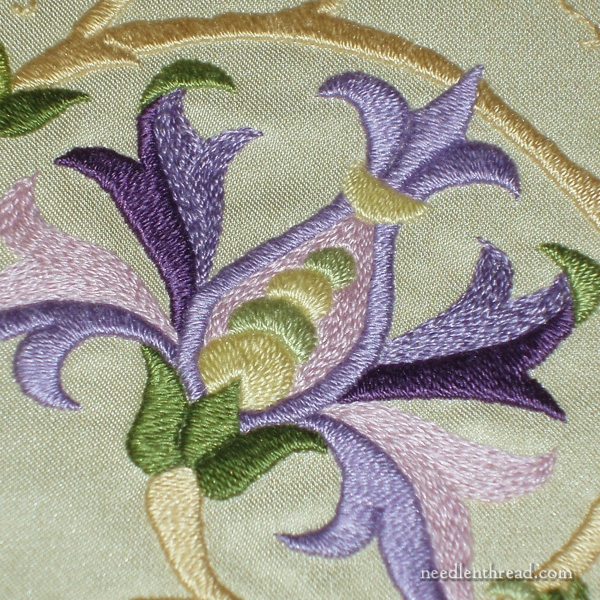
That’s not the only reason I don’t like the whole “focus on the fail” thing.
The main reason I don’t like it is that I think that what people consider a failure is not necessarily a failure.
Often, it’s a valiant effort that didn’t achieve the desired results.
But does that make it a failure?
I don’t think so.
In most situations in life, mistakes and failures are opportunities. They’re opportunities to learn. They’re opportunities to adjust the outcome to something unexpected or unplanned.
They might involved disappointment. They might be frustrating. But they don’t have to drag us down. And we don’t have to focus on them as “failures” as such.
Especially in needlework (which, in the Grand Scheme of Things, is not really a primal aspect of life), “failures” and “mistakes” are not life-shattering.
It is only thread. It is only fabric.
And a perceived mistake or failure can be fixed or forsaken. Life will still go on.
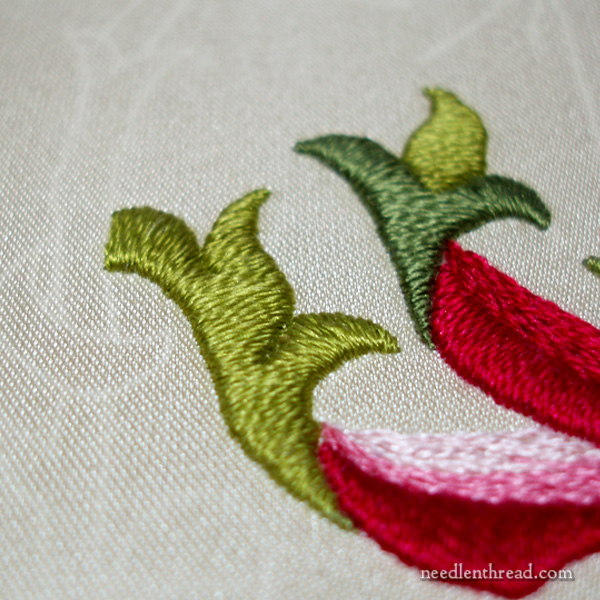
I have plenty of embroidery failures under my belt.
By failures, I mean the things I’ve done wrong with needle and thread – the projects that I started that didn’t turn out the way I wanted or hoped – or that didn’t turn out at all! Things that fell apart because I chose the wrong materials. Stitching that looked less than lovely because I didn’t have the knowledge or skill to pull it off. Bad choices in threads or fabrics or finishing materials. Careless cuts into fabric. Spills on embroidery! Spot damage! Color running!
Learning embroidery – or any type of needlework, art, craft, hobby – is a journey.
No one starts at Level Perfect. And no one (that I know of, anyway) ever achieves Level Perfect. We’re human. We make mistakes. And it’s ok.
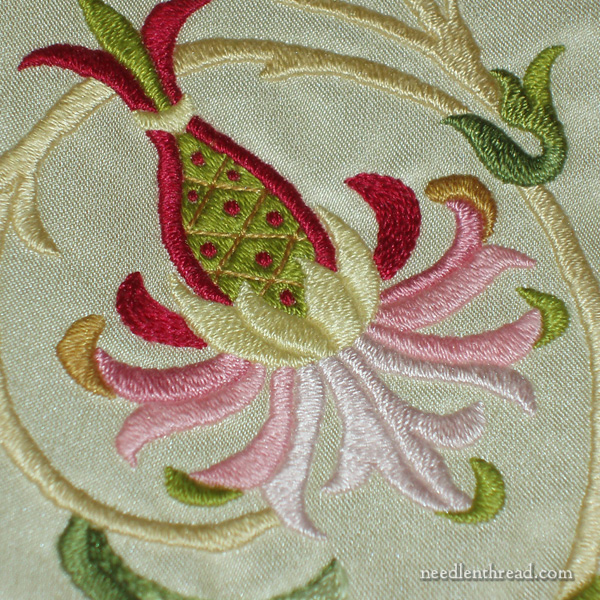
But, back to the topic and terminology. The Embroidery Fail that sticks in my head the most is this project pictured here.
If you have been hanging around Needle ‘n Thread since practically its beginning, you’ve seen this before.
I took a stole that was embroidered in the 1800’s and I set out to re-create it.
In the ecclesiastical sense, a stole is a long strip of material that passes behind the neck, over the shoulders, and down the front of a priest. Each side usually mirrors the other, so it’s essentially two more or less identical strips sewn together where they meet behind the neck.
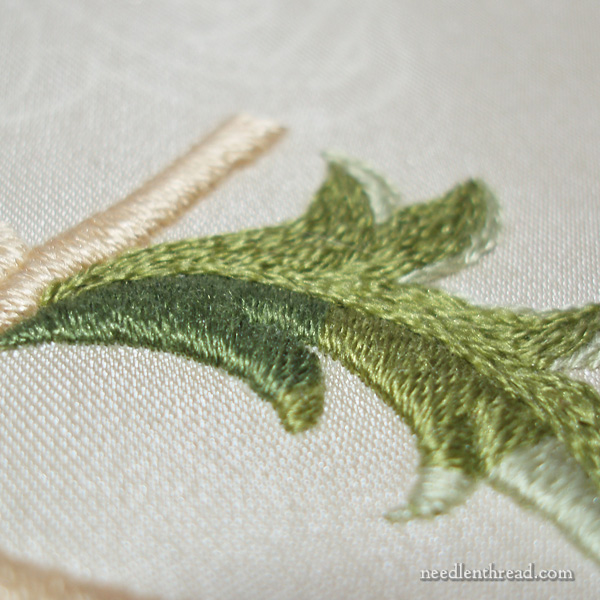
I copied the design by tracing it as best and as carefully as I could, and then by filling in with sketching where necessary. I made some modifications and then cleaned it up into a usable pattern.
I selected a beautiful Italian silk satin as the ground fabric. It was the nicest silk I’d ever seen and that I’ve ever seen since, and it was such a pleasure to stitch on! It was like … butter. Soft, pale, golden butter. What a fabric! I wish I had bought yards and yards and yards and yards of it! But even back then, it was $100/yard! And I didn’t really understand the value of what I had, anyway. I just knew I liked it!
For thread, I made the two-hour journey to the closest needlework shop available at the time and I color matched the back of the threads on the old stole with Soie d’Alger.
I invested in a boatload of that thread.
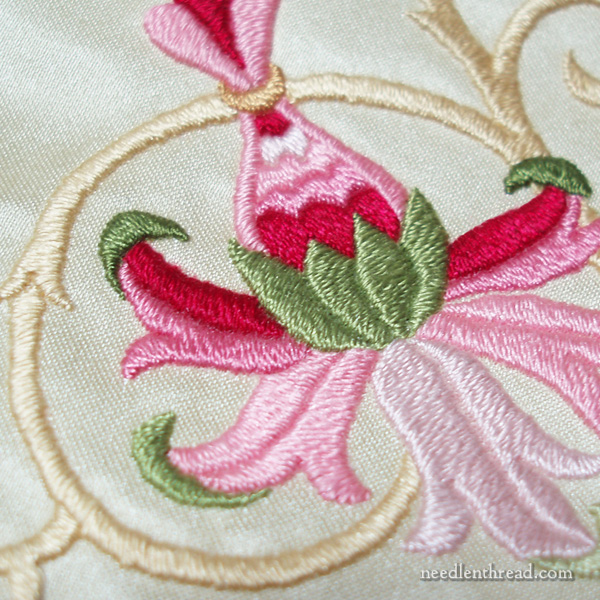
I didn’t really know threads the way I know them now, and the same abundance of threads was not as readily available. We enjoy such a rich profusion of threads these days!
If I knew then what I know now, I would have mixed up the types of silks. I would have used Soie de Paris, Soie Perlee, Soie Ovale, and Soie d’Alger!
The original stole was all satin stitch and split stitch, though, so I was safe with Soie d’Alger. But oh! If I were doing this project now! How I would change it!

It was a lot of satin stitching, that’s for sure.
What happened with the project?
I finished one side of the stole. If I ever get it out of storage, I will probably stretch it and frame it.
I was well along in the second half when we had company one night – a friend, her three year old, and her mother. She wanted me to show the embroidery to her mom. I hesitated because the three year old was there and was very active… and also eating M&M’s.
But they begged, and my ego got the better of me. I wanted to show it off! And perhaps therein lies the greatest part of this “fail.”
I took it out.
It all happened in slow motion. The embroidery came out, the three year old lunged, the gooey, slobbery M&M-hands stretched forth … and … blyck.
That ended that project. I just couldn’t face the clean up. Actually, I did try to clean it up, but then I couldn’t face cleaning up the failed clean-up.
I admit I was annoyed. The thread and fabric could be replaced, but the time and effort – not so much.
But that’s ok. I wouldn’t ruin a friendship over thread and fabric.
This is The Thing, though:
In a sense, the whole event saved the project.
After that, I learned so much more about this type of embroidery. I realize now that the stole would never have turned out the way I expected it to. It would have been puckered. There was no backing fabric behind the embroidery. I didn’t know how to finish this type of embroidery in a way to ensure longevity. My sewing skills were nil. There are so many little things that weren’t in place yet for that project.
I’ve always had it in my mind to work this project again. Now if I do it, I can do it with much greater confidence, with a plethora of wondrous threads, and with (I think) greater skill and better design sense, too.
I’m not sure I could ever find that fabric again, though. *Sigh*
Anyway, that’s probably the biggest project that sticks in my mind as a regretful end. I learned so much from it, though, that I don’t really consider it a waste.
As for fails, there are so many more. But I never really look at them that way.
And I hope you don’t, either!





